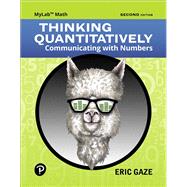NOTE: Before purchasing, check with your instructor to ensure you select the correct ISBN. Several versions of the MyLab™ and Mastering™ platforms exist for each title, and registrations are not transferable. To register for and use MyLab or Mastering, you may also need a Course ID, which your instructor will provide.
Used books, rentals, and purchases made outside of Pearson
If purchasing or renting from companies other than Pearson, the access codes for the MyLab platform may not be included, may be incorrect, or may be previously redeemed. Check with the seller before completing your purchase.
For courses in Quantitative Literacy, Quantitative Reasoning, or Liberal Arts Math.
This product includes MyLab Math.
Empowerment through numbers
It’s essential for students to understand, communicate, and make decisions with data they will encounter every day in their personal, civic, and business lives. Understanding the numbers behind real-life topics enables them to evaluate information and make confident choices.
Thinking Quantitatively, 2nd Edition empowers students to develop the critical-thinking and math skills they need to become informed and numerically literate citizens. This fully digital solution provides a seamless learning experience that includes Gaze’s text content, extensively revised Guided Worksheets with real-world examples, and auto-graded Excel® problems with immediate feedback. Students will be able to put their learning to practice immediately.
With new auto-graded Excel homework, Thinking Quantitatively also supports students in using Excel to directly analyze and interpret data. Additionally, students are now able to visualize data through the use of StatCrunch® applets throughout the eText.
Personalize learning with MyLab Math
By combining trusted author content with digital tools and a flexible platform, MyLab Math personalizes the learning experience and improves results for each student.
0135428262 / 9780135428269 THINKING QUANTITATIVELY: COMMUNICATING WITH NUMBERS MYLAB MATH WITH GUIDED WORKSHEETS -- TITLE-SPECIFIC ACCESS CARD PACKAGE, 2/e









